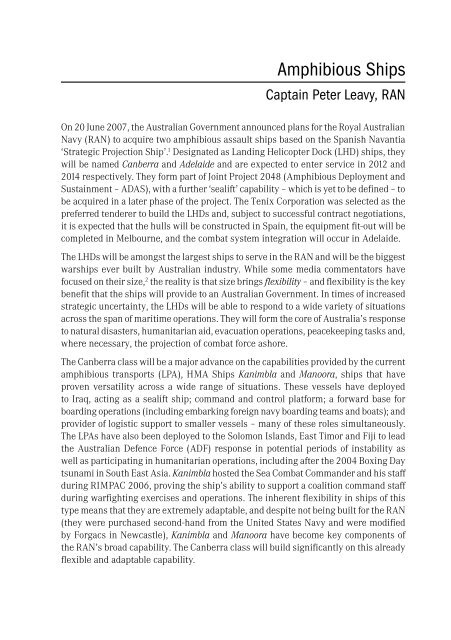Australian Maritime Issues 2007 - Royal Australian Navy
Australian Maritime Issues 2007 - Royal Australian Navy
Australian Maritime Issues 2007 - Royal Australian Navy
You also want an ePaper? Increase the reach of your titles
YUMPU automatically turns print PDFs into web optimized ePapers that Google loves.
Amphibious Ships<br />
Captain Peter Leavy, RAN<br />
On 20 June <strong>2007</strong>, the <strong>Australian</strong> Government announced plans for the <strong>Royal</strong> <strong>Australian</strong><br />
<strong>Navy</strong> (RAN) to acquire two amphibious assault ships based on the Spanish Navantia<br />
‘Strategic Projection Ship’. 1 Designated as Landing Helicopter Dock (LHD) ships, they<br />
will be named Canberra and Adelaide and are expected to enter service in 2012 and<br />
2014 respectively. They form part of Joint Project 2048 (Amphibious Deployment and<br />
Sustainment – ADAS), with a further ‘sealift’ capability – which is yet to be defined – to<br />
be acquired in a later phase of the project. The Tenix Corporation was selected as the<br />
preferred tenderer to build the LHDs and, subject to successful contract negotiations,<br />
it is expected that the hulls will be constructed in Spain, the equipment fit-out will be<br />
completed in Melbourne, and the combat system integration will occur in Adelaide.<br />
The LHDs will be amongst the largest ships to serve in the RAN and will be the biggest<br />
warships ever built by <strong>Australian</strong> industry. While some media commentators have<br />
focused on their size, 2 the reality is that size brings flexibility – and flexibility is the key<br />
benefit that the ships will provide to an <strong>Australian</strong> Government. In times of increased<br />
strategic uncertainty, the LHDs will be able to respond to a wide variety of situations<br />
across the span of maritime operations. They will form the core of Australia’s response<br />
to natural disasters, humanitarian aid, evacuation operations, peacekeeping tasks and,<br />
where necessary, the projection of combat force ashore.<br />
The Canberra class will be a major advance on the capabilities provided by the current<br />
amphibious transports (LPA), HMA Ships Kanimbla and Manoora, ships that have<br />
proven versatility across a wide range of situations. These vessels have deployed<br />
to Iraq, acting as a sealift ship; command and control platform; a forward base for<br />
boarding operations (including embarking foreign navy boarding teams and boats); and<br />
provider of logistic support to smaller vessels – many of these roles simultaneously.<br />
The LPAs have also been deployed to the Solomon Islands, East Timor and Fiji to lead<br />
the <strong>Australian</strong> Defence Force (ADF) response in potential periods of instability as<br />
well as participating in humanitarian operations, including after the 2004 Boxing Day<br />
tsunami in South East Asia. Kanimbla hosted the Sea Combat Commander and his staff<br />
during RIMPAC 2006, proving the ship’s ability to support a coalition command staff<br />
during warfighting exercises and operations. The inherent flexibility in ships of this<br />
type means that they are extremely adaptable, and despite not being built for the RAN<br />
(they were purchased second-hand from the United States <strong>Navy</strong> and were modified<br />
by Forgacs in Newcastle), Kanimbla and Manoora have become key components of<br />
the RAN’s broad capability. The Canberra class will build significantly on this already<br />
flexible and adaptable capability.
















